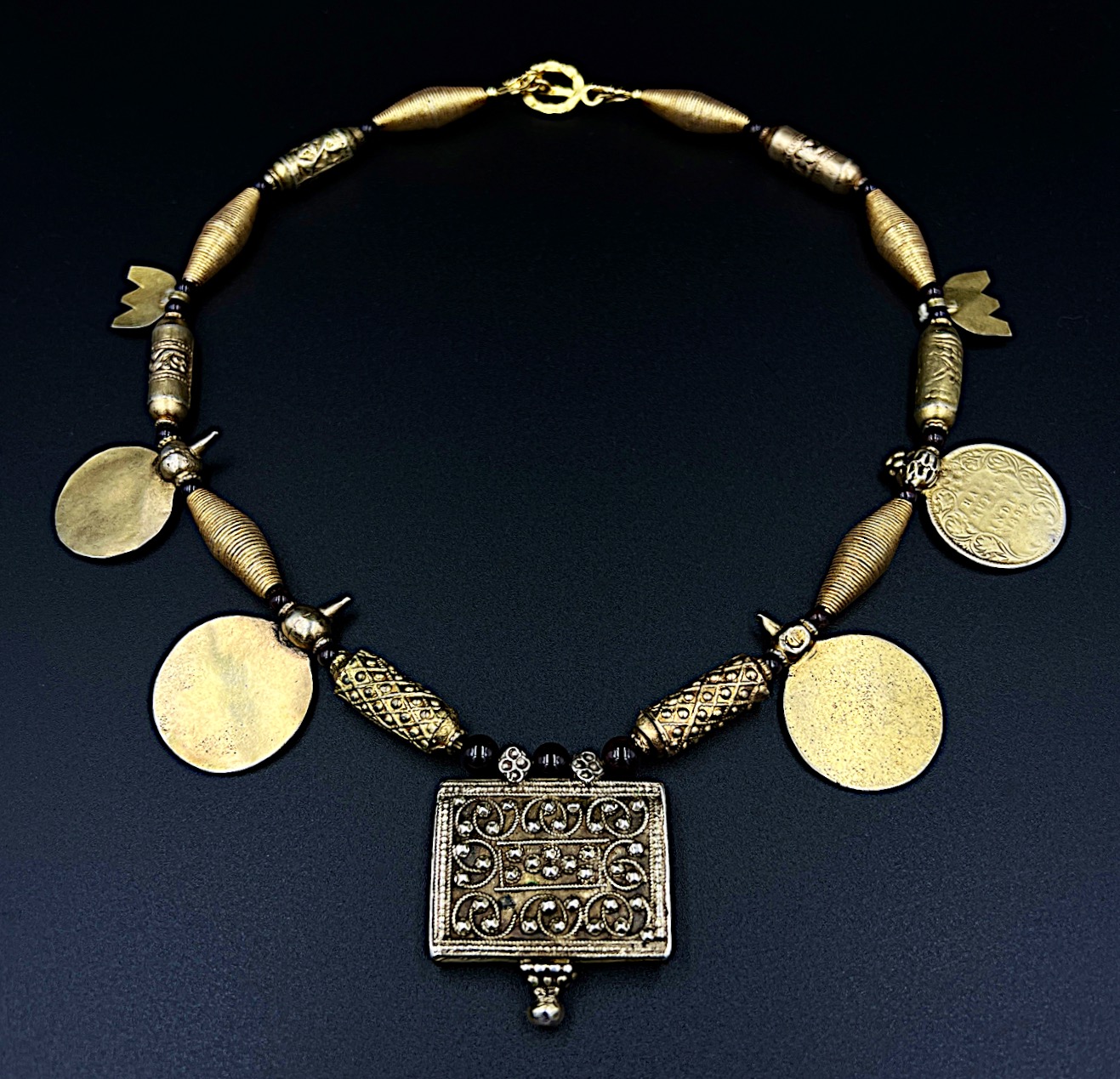

Title: 19th Century Antique Yemen Necklace Gold Beads and Garnets
Shipping: $29.00
Artist: N/A
Period: 19th Century
History: Art
Origin: Middle East > Syria
Condition: N/A
Item Date: N/A
Item ID: 444
Spectacular set of antique beads from the 1800s, Yemen – washed gold and garnets. Central is an amuletic Koranic pendant. The hands are hamsas. Carefully designed by the International jewelry artist Savanna Storm. She is recognized worldwide. Weight: 58gms Length: 19inches/48cms Gold washed Indian Rupee coin dated 1899, with Yemen filigree bail added to it. This garnets and gilt necklace was recently reassembled from old and antique Yemen gilt on silver beads, dating from late 1800’s to early 1900s. It’s made from pieces collected from broken traditional necklaces from the Mahra region of Yemen. It’s rethreaded with Indian garnets, and a recently made gold washed clasp from Bali. The coins represent wealth, the little hand shaped pendant could represent a good luck charm or hamsa, which were used as decoration on a Yemen bridal headdress. There is the whimsical addition of an old Indian Rupee. Beads like the granulated barrel shapes are seen in Marjorie Ransom’s book Silver Treasures from the Land of Sheba. Yemen, located on the south west point of the Arabian peninsula, and it’s proximity to Africa on the other side of the Red Sea, has for millennia been a significant trade route. It’s agricultural riches and location brought wealth, education and culture, resulting in it being the seat of kingdoms and empires. The legend of the Queen of Sheba originated when she arrived at King Solomon’s palace heavily adorned in gold jewellery. The area is rich is precious minerals and archeological research has shown that gold was mined and worked around al-Maraziq as early as 1000BC. Silver mines were in operation from around 10th century CE. Yemen’s traditional silver jewellery is intricate and artistic. Many of the Yemeni silversmiths were Jewish, who became famous for their skills that they passed down the generations. Many of their works were signed by the craftsman, which was a form of quality control and authentication. Each region had its own style, but shared their heritage. On the Red Sea coast, the jewellery resembles that crafted on the African coast on the opposite side. Towards the east there are Omani and Indian influences. Inland, jewellery shares its forms and shapes with Saudi Arabia. It’s often quite difficult to tell exactly which region Yemen jewellery comes from, but what all the regions have in common is a unique, recognisable style made with great skill. Although the Yemeni preferred gold jewellery to silver, not everyone could afford it. To make it look gold, the Yemeni craftsmen dipped their silver jewellery into a mixture of gold powder mixed with acid and water, which produced a light gold wash. But the Mahris softened gold to powder and mixed it with mercury, which was then applied to 83 percent silver, resulting in a gold wash that lasts much longer than other techniques.
(Made by Savanna Storm, once an international photojournalist who spent that part of her career photographing women in their tribal finery, until she decided to take home more than photographs. Since then, she’s spent her travelling years collecting beads and pieces to put into her creations. Her pieces are in collections worldwide. Antique tribal jewelry has significant historical value today for several reasons. Firstly, it is a tangible representation of the rich cultural heritage of Yemen, spanning several millennia and reflecting the influences of various civilizations that have inhabited the region. It also showcases the high level of craftsmanship and artistic skill that existed in ancient Yemen, particularly during the Islamic Golden Age. Secondly, antique Yemen jewelry is becoming increasingly rare as it is a luxury item, many pieces were lost over time and it is hard to find in good condition. As such, it is highly valued by collectors and enthusiasts of ancient art and history. Lastly, the historical and cultural significance of antique tribal art needs to be appreciated for its high level of craftsmanship and beauty.